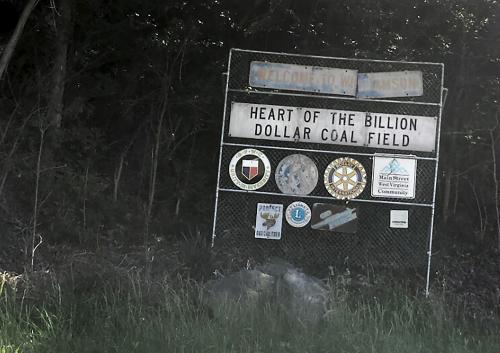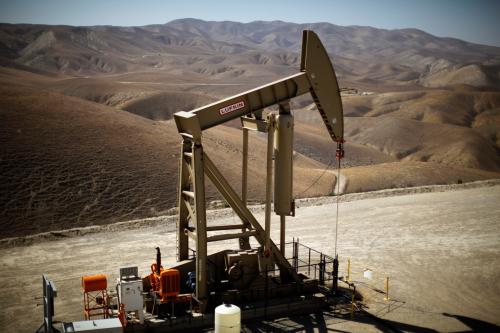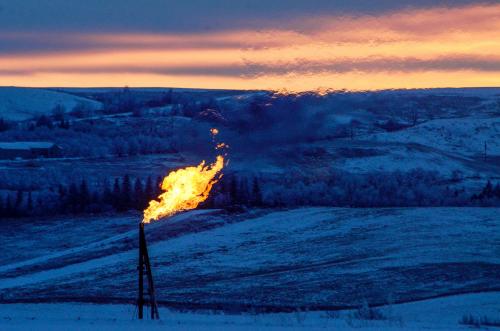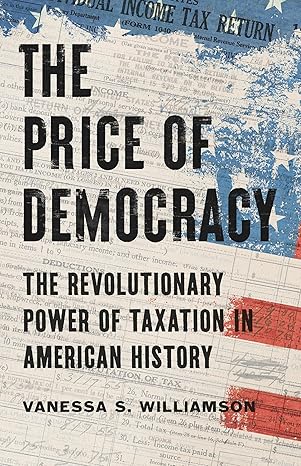Rachel Hampton is a policy analyst and Barry Rabe is the director of the Center for Local, State, and Urban Policy at the University of Michigan. An earlier version of this essay was published in the Pittsburgh Post-Gazette.
One would be hard-pressed to find a better poster child for the hydraulic fracturing industry than Pennsylvania. Billboards promoting natural gas litter the state’s highways. A Matt Damon film dubbed the state the Promised Land. As natural gas production has soared, the Keystone State has become an increasingly prominent energy exporter.
But the poster child of fracking has a dirty secret. It lags behind other major oil and gas producing states in tax policy. While most energy-producing states—as many as 38—tax resource extraction, Pennsylvania does not. All others, from Alaska to North Carolina, levy so-called “severance” taxes on oil, gas, or coal extraction. Revenues from such taxes allow these states to either address budget shortfalls, minimize other taxes, or invest in their future once drilling declines. Yet again, the Pennsylvania legislature is exploring the possibility of severance tax adoption, with yet another looming budget deadline and looming deficit. Governor Tom Wolf continues to push for such a step but still faces a difficult fight in Harrisburg.
Table 1: Top Producing Oil and Gas States
| Top Oil Producing States | Severance Tax? | Top Natural Gas Producing States | Severance Tax? |
|---|---|---|---|
| Texas | Yes | Texas | Yes |
| North Dakota | Yes | Pennsylvania | No |
| California | Yes | Oklahoma | Yes |
| Alaska | Yes | Louisiana | Yes |
| Oklahoma | Yes | Wyoming | Yes |
| New Mexico | Yes | Colorado | Yes |
| Colorado | Yes | New Mexico | Yes |
| Wyoming | Yes | Arkansas | Yes |
| Louisiana | Yes | West Virginia | Yes |
| Kansas | Yes | Ohio | Yes |
| Utah | Yes | Utah | Yes |
| Ohio | Yes | Alaska | Yes |
| Montana | Yes | North Dakota | Yes |
| Mississippi | Yes | Kansas | Yes |
| Illinois | Yes | California | Yes |
| Sources: U.S. Energy Information Administration, Rankings: Crude Oil Production, June 2016 (thousand barrels), available at https://www.eia.gov/state/rankings/#/series/4, accessed January 4, 2017. U.S. Energy Information Administration. Rankings: Natural Gas Marketed Production, 2014 (million cu ft), available at https://www.eia.gov/state/rankings/#/series/47, accessed January 4, 2017. National Conference of State Legislatures, State Severance Taxes, 2012, available at http://www.ncsl.org/research/fiscal-policy/2011-state-severance-tax-collections.aspx, accessed January 4, 2017. |
|||
States are often sensitive to border state tax policies. But even neighboring Ohio and West Virginia levy severance taxes and have done so for several decades. Ohio Republican Governor John Kasich is no fan of tax increases but has long argued that the state’s severance tax is too low, as this reflects the permanent loss of a natural resource. No state with a severance tax has ever seriously considered eliminating it since the Ulysses S. Grant presidency. Pioneering tax development in 19th-century, Texas continues to fund education from kindergarten through college.
But as we explore in a newly-published special issue of Commonwealth: A Journal of Pennsylvania Politics & Policy, Pennsylvania has remained the one exception to these trends. While it does employ a very modest “impact fee,” the Pennsylvania legislature routinely refuses to adopt a severance tax. Their fear: that industry will shift drilling elsewhere. But “elsewhere” these days means an energy-producing state or nation that already imposes a severance tax.
Pennsylvania’s failure to adopt this universally-applied tax has meant foregoing significant revenue. Indeed, some projections estimate that a Pennsylvanian severance tax would have generated around $350 million for the state in the 2016/2017 fiscal year alone, potentially enough to alter the state’s troubled fiscal situation.
Another consequence of Pennsylvania’s inaction is the lost opportunity to preserve revenues for longer-term challenges through a state trust fund. Such funds play the especially important role of safeguarding revenue during booms and busts. In many states such as Texas and Wyoming, these trust funds have remained stable and reliable across generations.
Table 2: State Trust Funds
| State | Trust Fund Title | Year of Adoption | Use of Earnings | Size of Trust (Principal as of 2016) |
|---|---|---|---|---|
| Alaska | Alaska Permanent Fund | 1976 | Citizen dividends and general fund | $53.9 billion |
| Montana | Coal Severance Tax Trust Fund | 1976 | General fund, education, infrastructure, remediation and economic development | $952.9 million |
| New Mexico | Severance Tax Permanent Fund | 1973 | General fund, education, infrastructure, and economic development | ~$5 billion |
| North Dakota | North Dakota Legacy Fund | 2010 | Undecided | $2.4 billion |
| Texas | Texas Permanent School Fund | 1854 | Elementary and secondary education | $37.7 billion |
| Texas | Permanent University Fund | 1876 | University of Texas | $17.2 billion |
| Utah | Permanent State Trust Fund | 2008 | Economic diversification, capital and infrastructure | $137 million |
| West Virginia | West Virginia Future Fund | 2014 | Earmarked for education, workforce development, infrastructure, tax relief projects | Not yet available |
| Wyoming | Permanent Wyoming Mineral Trust Fund | 1976 | General fund | $5.6 billion |
North Dakota’s Legacy Fund constitutes a more recent example, having stockpiled nearly $5 billion dollars in its first seven years of operation that now provides funds through careful investment to balance the state budget. North Dakota is a fiscally prudent state and neither Republican nor Democratic officials are tax advocates. But there is bipartisan agreement in the state that the Legacy Fund was a wise move—and likely should have been launched decades ago to build a better future. West Virginia adopted a more modest version of this fund in 2014.
North Dakota’s fund is modeled after the world-class Norwegian sovereign-wealth fund, which is preparing that Scandic nation for the inevitable decline and bust of oil production. Norway remains the global model for sustainable oil production, with extraordinary and sustained output, coupled with rigorous environmental protection and workplace safety policies, and a tax regime that underwrites a sovereign-wealth fund that has already amassed nearly one trillion dollars.
Pennsylvania, on the other hand, continues to resist any severance tax, much less a trust fund. This is ironic given its prolonged boom-and-bust history with fossil fuels and sizable long-term restoration costs after extraction ends. In Harrisburg, governors and legislators continue to squabble over whether drilling would continue in the event of a tax. In Bismarck, Austin, Denver and numerous other capitals, leaders decide how best to invest the proceeds from a tax that retains bipartisan support.
The Brookings Institution is committed to quality, independence, and impact.
We are supported by a diverse array of funders. In line with our values and policies, each Brookings publication represents the sole views of its author(s).











Commentary
Leaving money on the table: Pennsylvania’s resistance to taxing resource extraction
June 27, 2017